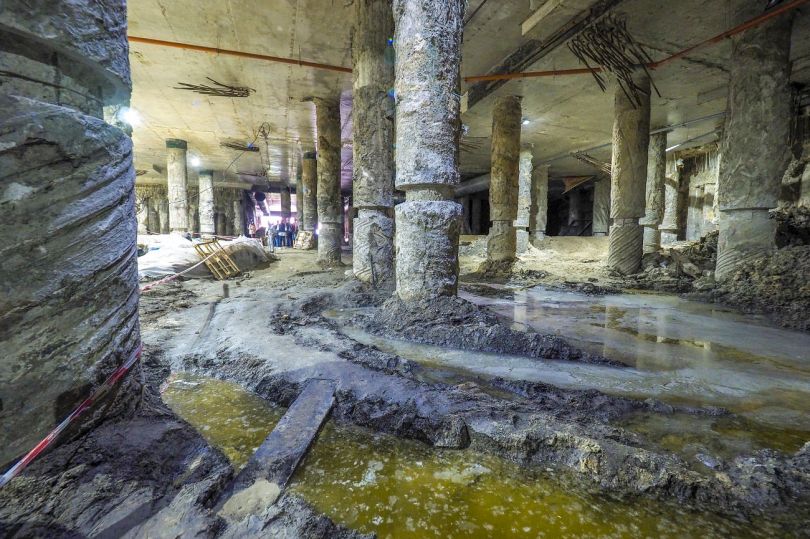Before 2015, the people of Kyiv didn’t suspect they were walking on the layers and layers of history on Poshtova Ploshcha. The historical discovery happened thanks to the excavation that was meant to prepare the area for another downtown shopping center.
According to doctor of historical sciences Mykhailo Sahaidak, the digging brought unexpected results: about 5-6 meters deep under the concrete and asphalt lay a whole system of what once was an ancient street. The excavation site immediately grabbed the attention of local archeologists and historians, who upon further prodding discovered that the street, in fact, was dating back to Kyivan Rus.
During three years the researchers explored layer by layer moving from the latest 18th to the early 11-12th centuries. The earth did a great job of keeping artifacts safe — the remnants of logs, pillars and fences of Kyivan Rus are still in good condition. A part of the Podil historical layer was unfortunately lost during building of transportation network. What remains, though, is astonishing in its details.
Ancient Kyiv Structure
 The excavation on Poshtova Ploshcha gives insight into the structure of Kyiv as it was during the existence of Kievan Rus. According to the research, the site could’ve been another hill, which led all the way to the funicular. The modern cableway in its turn was the old Borychiv Tik and the Ministry of Foreign Affairs was a temple of Old Slavic Gods. Like in many similar archeological discoveries, it’s not long until the diggers find human remains. The research, in fact, shows that the abundance of human bones located near the 12-13th centuries street used to be a small graveyard.
The excavation on Poshtova Ploshcha gives insight into the structure of Kyiv as it was during the existence of Kievan Rus. According to the research, the site could’ve been another hill, which led all the way to the funicular. The modern cableway in its turn was the old Borychiv Tik and the Ministry of Foreign Affairs was a temple of Old Slavic Gods. Like in many similar archeological discoveries, it’s not long until the diggers find human remains. The research, in fact, shows that the abundance of human bones located near the 12-13th centuries street used to be a small graveyard.
Archeologists also found the remnants of the drainage system dating back to the 17-18th centuries. Large wooden troughs collected water from the numerous Kyiv hills and met in one place constructed similarly to a pump room. These findings, among others, prove that Kyiv was larger than thought to be before. Even as far as the 11th century, the city was actively expanding to the south of Dnipro.
Important Artifacts
As mentioned before, the layers of the earth hide artifacts from the Old Kyivan Rus period. At the moment, the oldest finding is a stamp of Kyivan Rus prince dated the 11th century. An old underground quarter revealed an area that used to be a Middle Ages workshop of a craftsman who made glass bracelets. Neighboring the workshop was a Kyivan Rus customs with numerous seals to mark the goods, a large collection of coins, weapons and rivets that connected details of wooden vessels.To move to the more recent artifacts, archeologists found elements of the 17-18th-century guns in the same area, which hints at its strategic importance as a defense structure. Weapons, however, peacefully coexisted with other artifacts like ceramics or accessories for hundreds of years, proving that life in ancient Kyiv wasn’t always about waging wars.
Future of the Historic Site
 So far archeologists have explored the cultural and historical layer of the 11th century but according to different estimates, it’s far from being the oldest. If the researchers dig 5 meters deeper, they might find more interesting and far older artifacts. Naturally, the abundance of discoveries and their cultural importance brought the excavation to the public eye. After excruciating talks and numerous protests, the construction of a shopping center was stopped in favor of exploring the area.
So far archeologists have explored the cultural and historical layer of the 11th century but according to different estimates, it’s far from being the oldest. If the researchers dig 5 meters deeper, they might find more interesting and far older artifacts. Naturally, the abundance of discoveries and their cultural importance brought the excavation to the public eye. After excruciating talks and numerous protests, the construction of a shopping center was stopped in favor of exploring the area.
According to the Head of the Department of Culture at Kyiv City Administration, a museum will appear on site when the archeological works are finished. Archeologists in their turn hope the museum will be interactive and able to offer online maps and apps. Soon Kyiv will see what the future and past have in store for us.
Source: styler.rbc.ua
Photo source: Serhii Korovainyi / RadioSvoboda.org, Vitalii Nosach / styler.rbc.ua, shutterstock.com. All images belong to their rightful authors.










